The best summer pear varieties: description and characteristics
Summer pear varieties are in demand among experienced and beginning farmers, housewives and cooks. A fragrant and fragrant harvest appears on the table in July and August. The beautiful fruits are rich in vitamins and are suitable for children's and dietary nutrition.
When choosing a variety, pay attention to the timing of planting and the year of fruiting of the tree, the taste and appearance of the fruit. The article will tell you about popular summer pears, their characteristics and recommendations for growing.
Distinctive characteristics of summer pear varieties
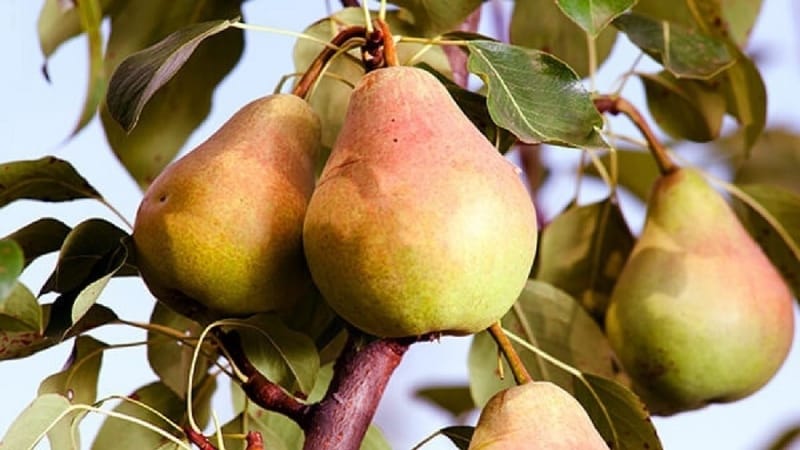
Summer varieties ripen in early or mid-July. Most pears ripen gradually, so gardeners enjoy a fresh harvest within 2-4 weeks. The taste is juicy and sweet, pears are consumed fresh and processed. Summer varieties are suitable for growing in the southern and northern regions and are unpretentious in care. Plants are resistant to diseases, which ensures stable yields from year to year.
If the pear has a thick peel, then the fruits are grown for sale - they do not deteriorate during long-term storage and transportation. The fruit size is medium, the pulp is dense. Summer varieties are drought-resistant, but require regular feeding. Mineral and organic substances are necessary for the pear to ripen in time for harvest.
Attention! It is recommended to collect the fruits on time, avoiding overripening. Otherwise, the pears will become soft and lose their presentation.
List of the best summer varieties: description and characteristics
To choose a variety suitable for your region, it is worth knowing the characteristics of their cultivation, the taste and appearance of the fruit, and yield indicators. Each variety has advantages and disadvantages. A review and description of the characteristics of the most popular summer crops will help you make the right choice.
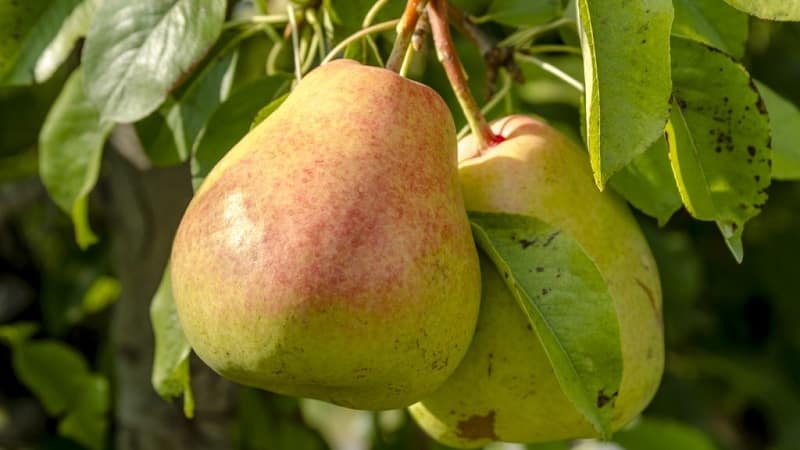
August dew
The trees are low-growing, fast-growing, the crown is small and spreading. The leaves are dark green, with pointed tips. The fruits are light green, some have a subtle red blush on the side. The skin is smooth and strong, the stalk is short.
The pulp is white, granular in structure. The taste is sweet and sour. August dew ripens by mid-August, the shelf life of the harvested crop is no more than 14 days. The trees bear fruit in the fourth year after planting and are rarely affected by scab. Winter hardiness - down to –24°C.
Bashkir summer
The plant is tall, the crown is pyramidal, spreading. This unpretentious variety produces a harvest in the second half of August. The flowers are snow-white, beautiful and fragrant. The fruits weigh 70 g and are yellowish-green. The surface is smooth, without bumpiness, with an oily peel. The pulp is tender, sweet and sour, with a pleasant aftertaste. Shelf life after harvest is 2 weeks.
Bashkir summer is distinguished by its transportability. Keeping quality is average. To obtain a bountiful harvest, pears are planted on nutritious and loose soil. The early summer pear is unpretentious in care.
Whiteleaf
The tree reaches a height of 4.5 m. The crown is of medium density, the branches grow upright. Fruits from 60 to 110 g, slightly ribbed. The peel is dry to the touch, light yellow in color with pinkish tints. The stalk is thin and curved, the pears are easily separated from the branch.
The pulp is creamy, the seeds are brown and small. The taste is astringent, sweet and sour, rich aroma. Late summer pears are removed from the tree at the end of August; the shelf life in a cool and dark place is no more than 10 days. Whiteleaf is resistant to insect pests, and the variety is universal in use.
Attention! For planting summer varieties of pears, choose breathable soil with an admixture of clay. Southern, western and southwestern garden plots are suitable. The tree is placed in the hole so that the root collar is located at a distance of 3 cm from the soil level. After planting, the tree is watered, mulched and tied to a wooden peg.
Bere Giffard
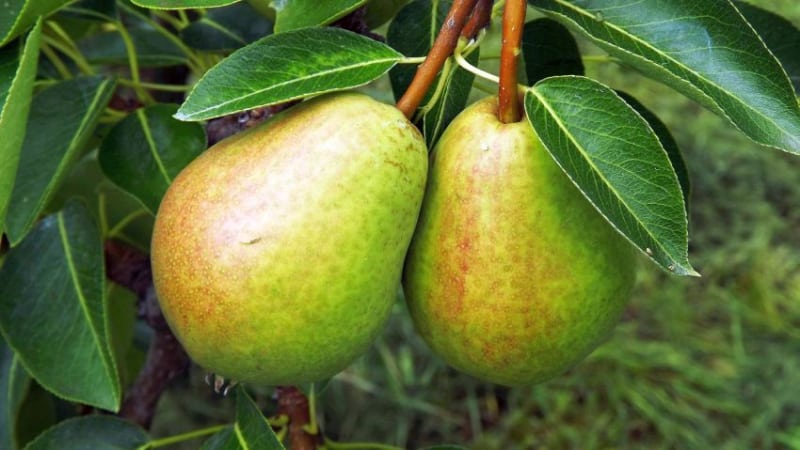
The tree is tall, reaching a height of 3 to 5 m. The root system is powerful, the shoots are strong and spreading. The fruits are greenish-yellow, the skin is thin. The shape is classic pear-shaped, weight from 70 to 100 g. The pulp is sweet, with a slight sourness, tender and juicy.
The tree bears fruit in the sixth year after planting. It is rarely affected by scab and does not tolerate frost. Pears are planted mainly in warm regions. Harvest after July 15th. Pears are eaten fresh and used for cooking. The variety is popular in the south of Russia, Armenia, and Ukraine.
Victoria
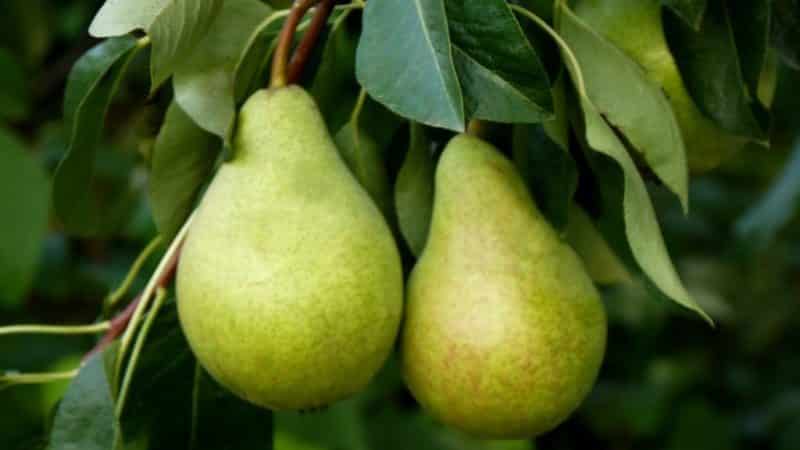
Large-fruited universal variety. The fruits are smooth, regular pear-shaped. The skin is yellow with a blush, there are many subcutaneous points. The average weight of a pear is 225 g, the flesh is white, juicy and sweet.
Ripening date is mid-August, shelf life up to two months. The long stalk holds the fruits on the tree, so after ripening they do not fall off for another 2-3 weeks. Sets quickly, resistance to fungal diseases is average. In the first years after planting, trees are covered for the winter.
Great Summer
The summer frost-resistant variety ripens by early or mid-August. The tree is medium-sized, with a spreading and wide crown.
The fruits are smooth, yellow-green in color, each weighing about 200 g. Small black subcutaneous dots are visible. Fruiting begins in the fourth year after planting. The taste of Great Summer is sweet, without astringency. The variety is planted in central Russia.
Attention! Fertilizers are applied from the second year of planting. Mineral - annually, organic - once every three years. On average, 8-10 kg of humus, 15-20 g of urea, 20 g of potassium chloride are used per 1 m² of land. Fertilize the pear after watering - this way the nutrients do not evaporate from the surface of the soil. In addition, foliar feeding is used - the pear is sprayed with the preparation "HOM" to protect against rodents and insects.
Duchess
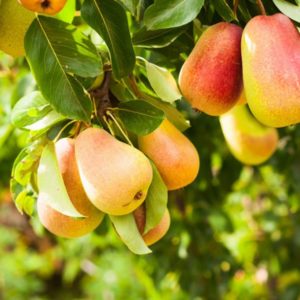
The popular Duchess variety is grown in the south and central regions. Pear inflorescences are large. The height of the tree is up to 5 m, the crown is pyramidal, spreading. The weight of the fruit is about 180 g, the surface is slightly ribbed.
The peel is thin, yellow-brown in color, with a small dot. The pulp is creamy, aromatic and sweet. The variety is valued for its taste, but Duchess often suffers from scab and aphids.
To obtain a harvest, pollinating varieties are planted nearby - Forest Beauty or Kappa's Favorite. Harvest at the end of summer. The fruits make delicious jam, dried fruits and confitures.
Carmen
A fast-growing tree with a small pyramidal crown. The weight of the fruit is from 60 to 100 g, the peel is dense and dry. A ripe pear acquires a rich burgundy or red color, and dark subcutaneous dots appear. The pulp is semi-oily, pleasant to the taste, juicy, creamy in color.
The Carmen variety ripens at the end of August.It is valued for its stable yield and drought resistance. Fruiting begins in the fifth year. It is recommended to grow Carmen in central Russia. Traditional care: watering, fertilizing and regular pruning of dry shoots.
Cathedral
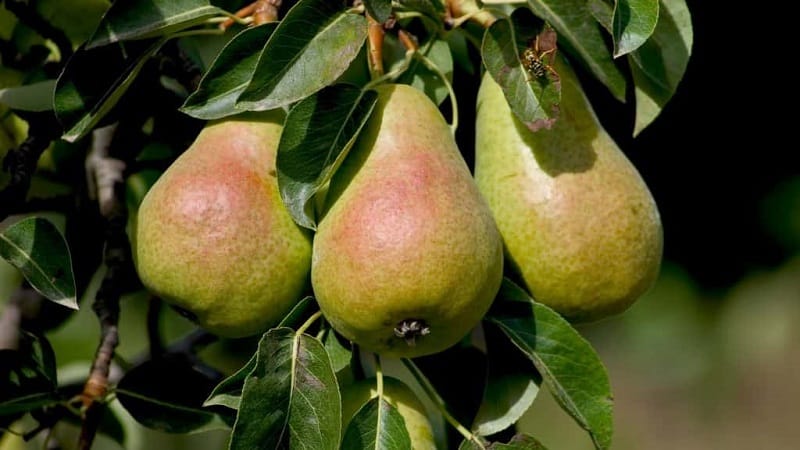
Pear Cathedral ripens by the end of July or beginning of August. The weight of the fruit is from 70 to 110 g, the shape is slightly flattened, pear-shaped. The surface is smooth with small bumps, oily to the touch. During the ripening period, the pear is yellowish, and subsequently acquires a reddish tint. The pulp is granular, creamy white, juicy, with a delicate aftertaste. The fruits are stored for up to two weeks.
The harvest is eaten fresh or made into jam, juice, and jelly. For storage, pears are placed in a dry wooden box, covered with newspapers and placed in a dark basement.
Summer oily
Wide and spreading trees bear fruit in the fifth year after planting. Dry areas located away from groundwater and drafts are suitable for growing. The weight of the fruit is 150-200 g, the color is green-yellow with an orange side. The taste is refreshing, tart, sweet and sour.
The variety is winter-hardy and is rarely affected by rodents and insects. Summer oily fruit bears fruit annually; healthy dried fruits and snacks are made from pears. Oily is grown for personal consumption and for sale in large quantities.
This is interesting:
The best pear varieties for the Moscow region
Chemical composition of pear, calorie content and its health benefits and harms
Limonka
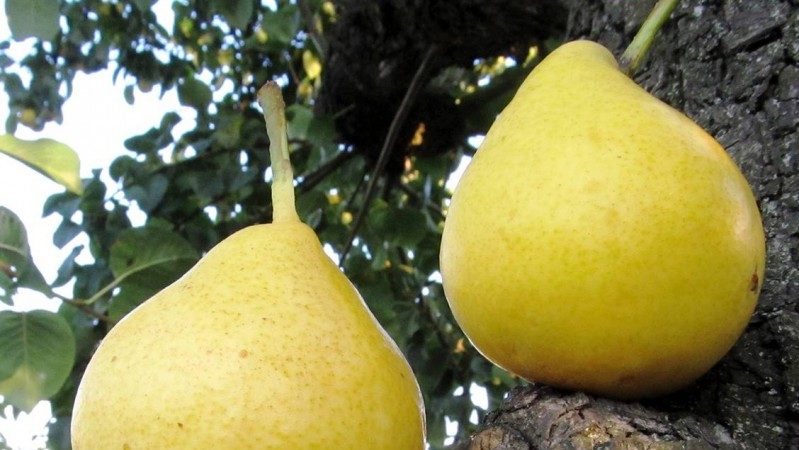
Limonka is a variety of breeders from Ukraine. The trees are tall and spreading, up to 6 m. The branches are straight and fast-growing, the crown is rounded. The variety is unpretentious to soil and is suitable for cultivation throughout the country. The weight of the fruit is about 70 g, the shape is ovoid, elongated.
The variety got its name due to its light yellow color. The pulp is dense, yellowish-white, pleasant to the taste. Suitable for making jam and marmalade for the winter. Disadvantage - Limonka bears fruit only 8 or 9 years after planting. The fruits ripen at the end of August, and after picking they are stored for no more than one week.
Attention! Not only winter preparations are prepared from the delicious summer pear, but also pies, casseroles, muffins and pancakes. Recipes for preparing nutritious salads are also popular, in which sweet pear pulp is combined with chicken breast, shrimp, eggs, bell pepper, and pork.
Rogneda
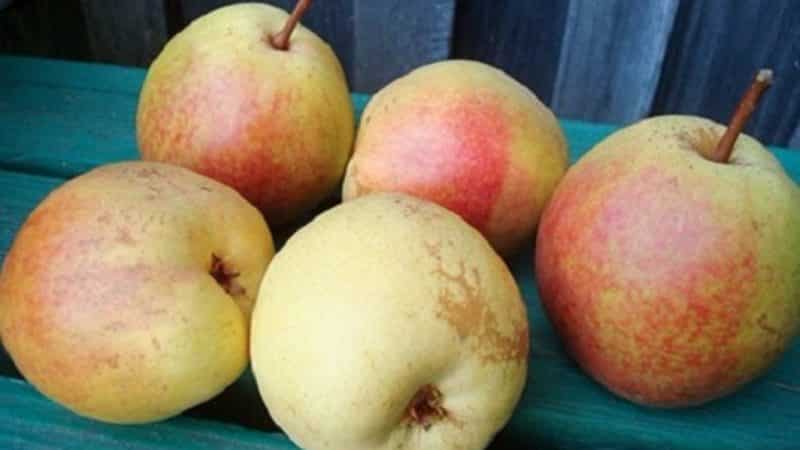
In warm regions, Rogneda produces a harvest at the end of August, in cold regions - at the beginning of September. The tree is medium-sized, with a compact crown, suitable for small garden plots. The variety is partially self-fertile, flowering occurs quickly, and the flowers are resistant to sudden temperature changes.
The shape of the fruit is round, the weight of the pear is about 120 g, sometimes reaching 150 g. The skin is shiny and smooth, the thickness is average. The color is light yellow, with a reddish blush on one side. The pulp is semi-oily, sweet, with a pleasant nutmeg aroma. Gardeners harvest the first fruits 3-4 years after planting.
Due to its early fruiting and winter hardiness, Rogneda is successfully grown in Siberia and the Urals. The fruits and leaves are resistant to rot and scab, after ripening for 10 days they do not fall off and sit tightly on the branch.
Sugar
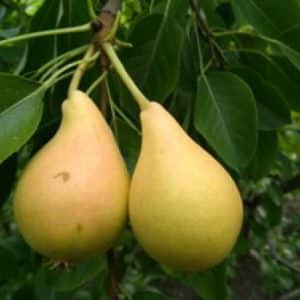
The yellow-pink fruits look appetizing on a tree and will decorate any garden. The plant is tall; a spacious and sunny area is chosen in advance for planting. The age of fruiting is from 5 to 7 years, depending on the quality of the soil and weather conditions.
The weight of the pear is 150-200 g, the shape is spherical. The taste is sweet and juicy, the flesh is medium oily.If the tree lacks moisture during ripening, the fruits acquire a sour, tart taste. The Sugar pear variety is universal in application.
Severyanka
The semi-spreading tree reaches 3-5 m in height. The crown is spreading, the foliage is average. The shape of the fruit is conical, pointed. Weight is about 120 g, the color is yellow-green, the peel is slightly lumpy. The pulp is fine-grained, the sweetness is medium.
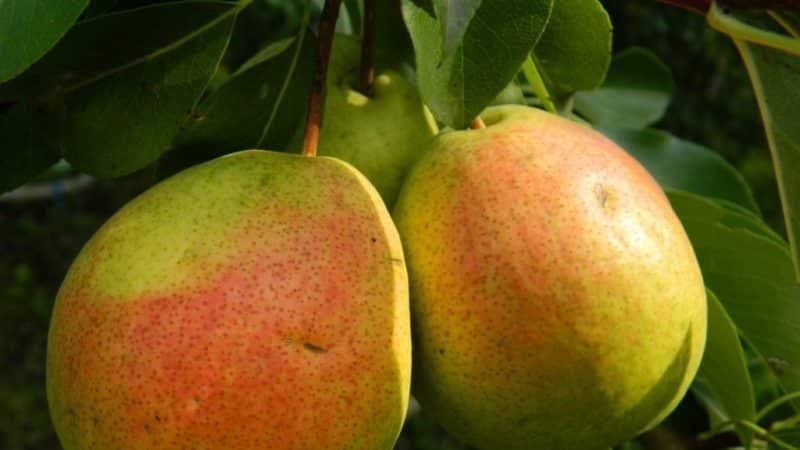
The ripening period begins at the end of July; at the beginning of August, gardeners are already harvesting. The shelf life of the fruit is no more than two weeks. Resistance to diseases is high - Severyanka is rarely affected by powdery mildew and fruit rot.
Conclusion
For cultivation in the Moscow region and Krasnodar region, mid- and late-summer varieties are chosen - Carmen and Duchess. The fruits grow juicy and oily, with a pronounced taste. Severyanka and Rogneda are suitable for planting in cool regions; the varieties are winter-hardy, easy to care for, and rarely get sick. Most summer pears have a shelf life of no more than two weeks. The fruits are used for processing into compotes or jam, eaten fresh, and made into dried fruits.